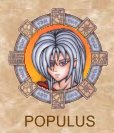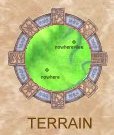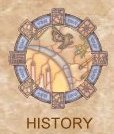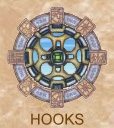|
Capital: Population: Majority: Government: Religions: Exports: |
170 000 (30% slaves)
Human
Satrapy (Tamaran-controlled)
None (banned)
Timber, iron, copper, chith, slaves
The south-western tier of Penduk is the territory of Erdanis (Ur-dan-iss), a series of small baronies that share a common alliance with the Tamaran Empire. Most of Erdanis is temperate, a combination of grasslands, deciduous forests, low mountains, and rivers. The southern portion of the territory is quite arid, steadily being swallowed by the desert spreading around the ruined Spiral collector of Arborat. Erdanis is populated largely by humans, and while the majority of the population is loyal to the Decider, most of the baronies are at war with each other over territory and trade routes. The rest are slaves of various non-human races, such as skoles, koba, and lutrai. Throughout the six baronies, non-humans are generally treated poorly, assumed to be slaves, or escaped slaves. Only the gorgs are exempt from this bias. Everyone loves the gorgs. They run the financial infrastructure of the entire region, and cooperate far more insideously than the bickering barons. Some even speculate that the gorgs are both orchastrating and funding this perpetual state of aggression from all six sides.
Only the major cities are shown here, each a veritable fortress. Scattered around them lie scores of small towns and villages that are often subjected to the effects of the petty feuds going on between the Erdani baronies. Much of the fighting was brought to a halt when the barons signed their loyalties over to the Decider, though the residual hostilities still remain. Now and then, these hostilities will errupt into bloody conflicts that last only as long as the Decider does not step in and put and end to them. The most significant conflicts stem from the rival cities of Keipan and Veccas, on either side of the bay, though even this ancient hostility is swept under the rug whenever the Tamarans show up to make use of the inland waterways to transport slaves or materials. Further upriver, the baronies of Daen, Savagnos, and Zeskoi continue to compete over the use of the great inland river, the Tethys.
Further south, the effects of the Wasting have taken hold despite the treaty between the Spiral and the Tamaran Empire. The very first collector was constructed in the southern desert, and later destroyed by the Creator war machine, Nigh. Arborat has infused the desert itself with a malevolent intelligence that causes it to spread outwards, an effect that has given it a more sinistre name - the Creeping Wastes. This cursed region continues to expand in all directions, even into the territories of Haun and Slank. It has already swallowed the former barony of Narada and the hidden hoomiku monestary, Deca, and unless it is stopped, the expanding desert will eventually devour the whole of southern Erdanis.






THE RIVER TETHYS
Stretching from Blacksail Bay to Icewell Lake, the Tethys forms the backbone of all transportation and distribution of goods throughout the six baronies. During the warmer seasons, barges and small ships are a common sight. The Tethys is very wide but fairly shallow at its terminating point, but much deeper and wilder near its origin in Icewell. Its waters are cold and very clear, with many varieties of fish.

SENTIENT DESERT
The region known as the Creeping Wastes is a desert possessed by the poisoned spirit of Ir'Heon, first of the Spiral Lords. This region is completely dead, infested with sand wraiths, and blighted by the ancient afterglow of Nigh's weapons, which makes it rather unplesant to anything that has a pulse. Worse still, the desert shifts and alters itself to confuse travelers.